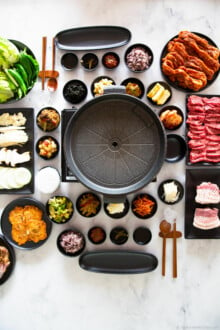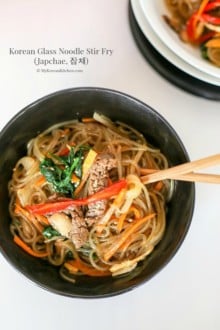Fragrant perilla leaves wrapped around a savory mix of ground meat and tofu. This is kkaennip jeon. Lightly golden on the outside, tender and juicy on the inside, it’s one of those beloved Korean side dishes you’ll almost always find on the holiday table or at family gatherings. And once you taste it, you’ll see why it’s such a favorite.
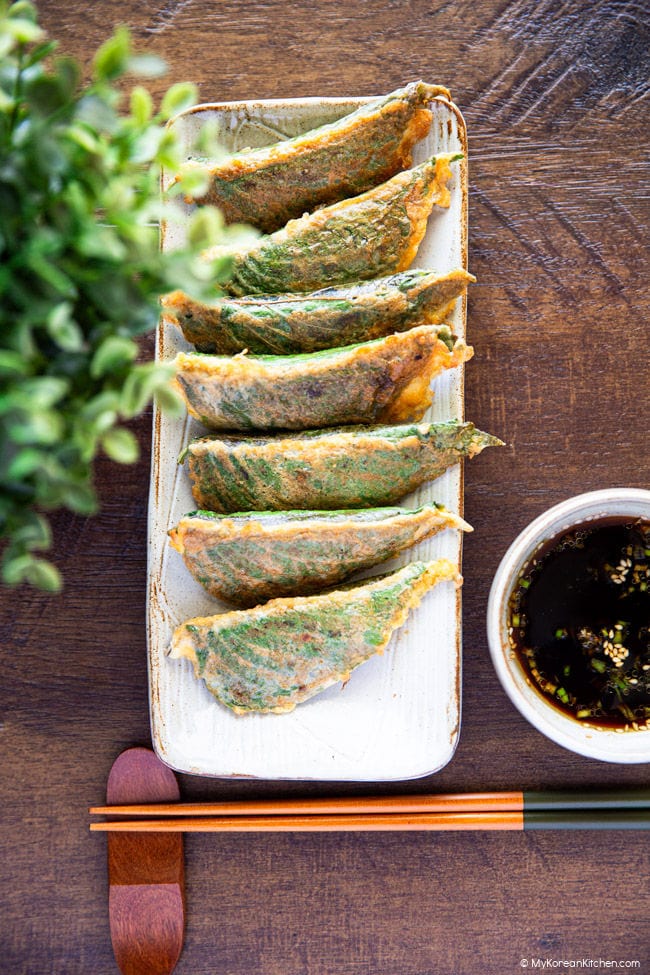
What is Kkaennip Jeon
Kkaennip jeon (깻잎전) is a Korean pan-fried dish made with perilla leaves stuffed with a savory filling, usually meat, tofu, and vegetables, lightly coated in egg, then gently fried until golden. The outside has a delicate egg layer that’s soft, while the inside stays juicy and flavorful. The perilla leaves soften as they cook but still keep their unique herbal aroma with a hint of sesame like nuttiness. It’s a classic home style banchan you’ll often see at family tables or holiday gatherings, simple yet so comforting.
Why You’ll Love This Recipe
Pre-cooked filling for better texture and flavor: The main reason I like pre-cooking the meat is that it shortens the frying time once the leaves are stuffed. If you cook them too long, the filling can dry out and the perilla leaves can overbrown. Pre-cooking solves this, giving you a juicier filling and leaves that stay tender and lightly golden.
Pork preferred, but flexible: Both ground pork and beef will work in this recipe. Beef gives the dish a more premium feel, while pork brings a slightly richer flavor and a more tender bite. I personally prefer pork, but either choice makes a delicious jeon.
Balanced mix-ins: The filling is lightened with tofu and finely chopped vegetables, which add moisture, softness, and extra flavor without making it heavy. The finely chopped vegetables also give a subtle texture contrast. Without them, the filling can feel like just a mushy clump.
Foolproof results: With these small tweaks, the jeon turns out tender and juicy inside, delicately golden on the outside, and full of savory flavor every time.
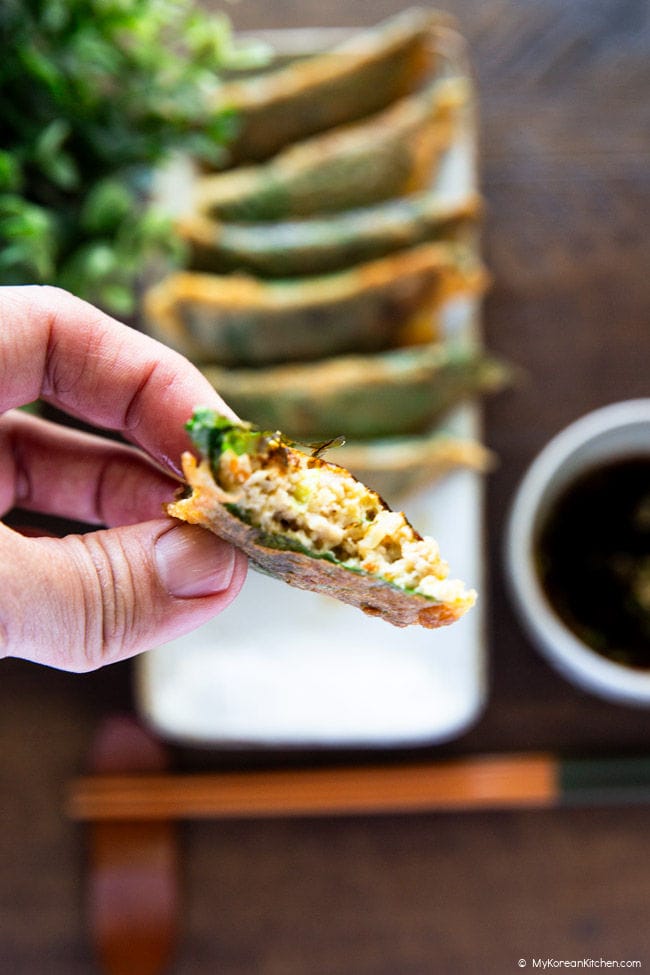
Ingredients
Filling
- 160 g (5.6 oz) ground pork or beef
- 1/2 Tbsp soy sauce, Sempio 701 Yangjo Ganjang (샘표 양조간장 701) or Kikkoman brand
- 1 tsp oyster sauce
- 1/2 tsp mirin (sweet cooking wine)
- 1 Tbsp minced garlic
- 1/8 tsp sesame oil
- A pinch of black pepper (or to taste)
- 50 g (1.8 oz) firm tofu, pressed to remove excess water and finely crumbled
- 50 g (1.8 oz) onion, finely chopped
- 20 g (0.7 oz) green onion, white part, finely chopped
- 30 g (1 oz) carrot, finely chopped
- 1 egg
- 2 Tbsp Korean pancake mix (buchim garu) or plain flour
Wrapping
- 11 perilla leaves (kkaennip), medium, rinsed
Coating
- 1/4 cup plain flour, for dusting
- 2 whole eggs plus 1 egg yolk, beaten with 1/4 tsp fine salt
- Cooking oil, for pan-frying
How to Make Stuffed Perilla Leaves
1. Season the meat
In a mixing bowl, combine the ground meat with the seasoning (soy sauce, oyster sauce, mirin, garlic, sesame oil, and black pepper). Mix well until evenly coated, then cover and let it rest while preparing the other ingredients so the flavors soak in.
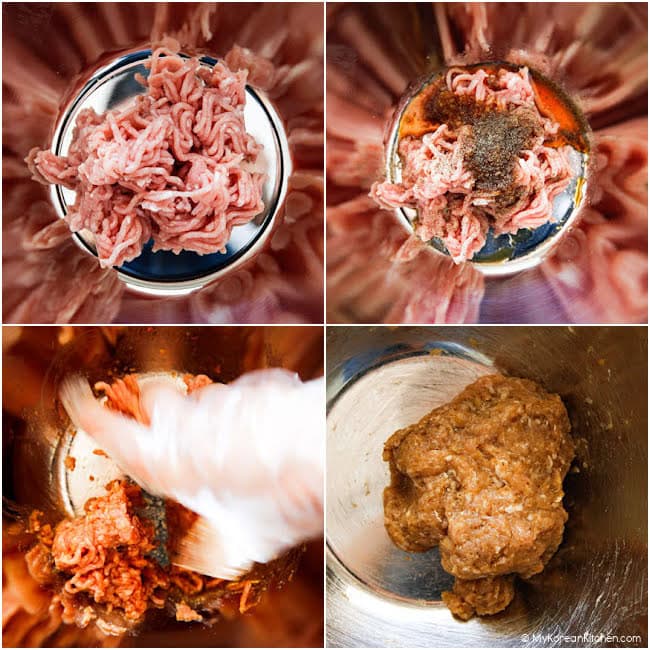
2. Cook the meat
Heat a lightly oiled pan over medium high heat. Add the seasoned meat and cook for 3 to 4 minutes, just until the color changes and most of the liquid evaporates. It doesn’t need to be fully cooked at this stage, since it will finish cooking once stuffed inside the perilla leaves. Break up any large clumps with a spatula as you stir.
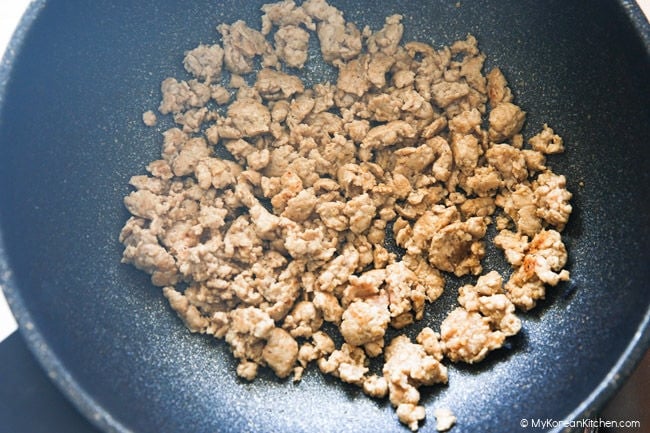
3. Prepare the filling
In a mixing bowl, combine the cooked meat with the tofu, onion, green onion, carrot, egg, and pancake mix. Mix by hand until the mixture feels sticky and cohesive. This texture will help it hold together as it cooks.

4. Coat and stuff the perilla leaves
Lightly coat the back of each perilla leaf (the back side with the veins showing) with flour. Press it gently into a plate of flour, then shake off any excess. This helps the filling stick and keeps the front clean for a lighter finish. Spoon a small amount of filling onto one half of the leaf, then fold the other half over to cover and press lightly to seal. Repeat with the remaining leaves.
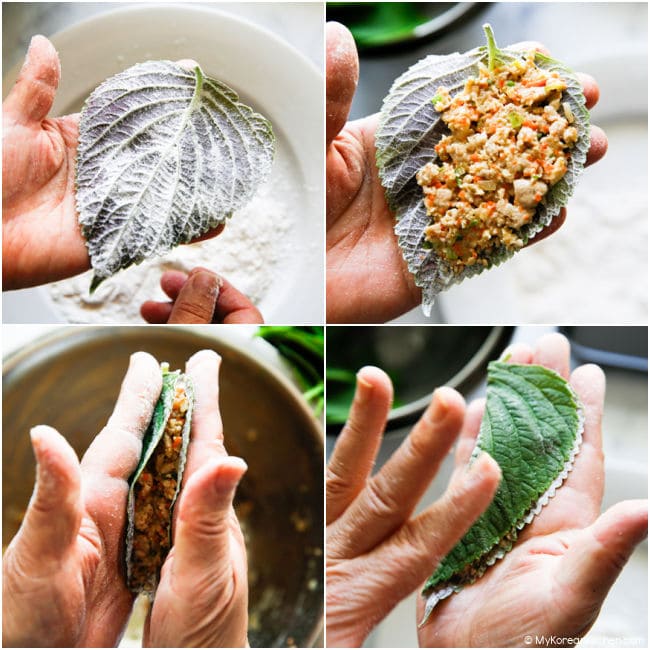
5. Pan fry the jeon
Heat a non-stick skillet over medium heat and add a thin layer of oil. Working one at a time, dip each stuffed perilla leaf into the beaten egg, coating both sides evenly, then place it straight into the pan. Fry in batches until golden brown and lightly crisp, about 2 to 3 minutes per side. Transfer to a plate lined with paper towels to drain excess oil. Serve warm.
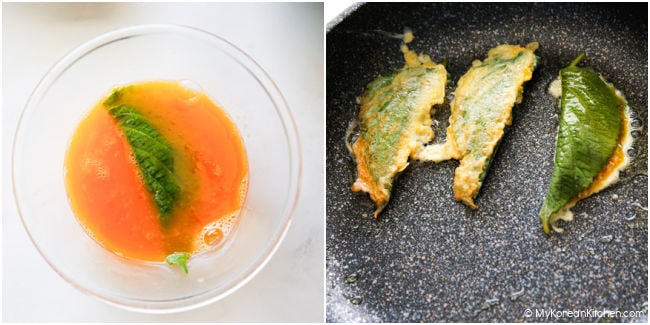
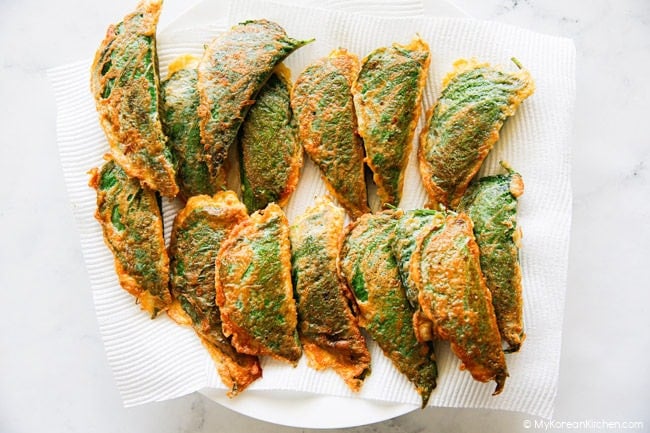
My Best Tips
- Chop the vegetables finely: This makes the filling smoother and easier to spread inside the perilla leaves. Bigger chunks can tear the leaves or make the jeon feel uneven.
- Cook the meat just briefly: In step 2, cook the meat only until it loses its raw color and most of the liquid evaporates. It will finish cooking inside the leaf, so don’t overdo it or the meat can dry out.
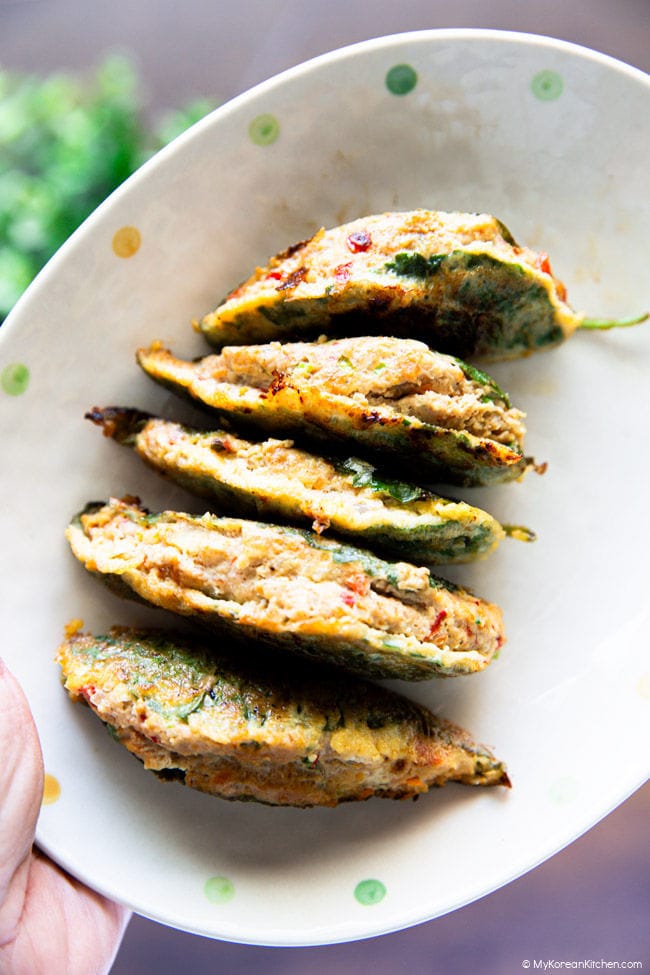
- Which side to stuff? Traditionally, the filling is placed on the back side of the leaf (the side with the veins showing). Apparently, the slightly rough surface helps the filling stick, and it leaves the smooth, greener side on the outside for a prettier finish. But don’t worry if you mix it up. It will still taste delicious. The only difference is the filling may slip a little more and the jeon might not look quite as neat.
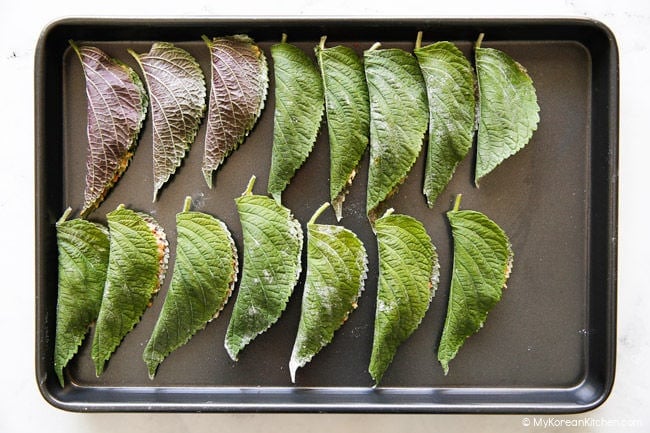
Serving and Storage
Perilla leaf jeon is best warm, right off the pan, with a simple soy dipping sauce if you like. Usually, though, it’s served with a bowl of steamed rice as part of a Korean meal spread, alongside other side dishes like kimchi.
Store leftovers in an airtight container in the fridge for up to 2 days. Reheat in a lightly oiled skillet or in an air fryer to bring back the crisp edges. Microwave will soften them. They can be frozen for up to a month, though the texture is best when freshly cooked. Reheat in a skillet or air fryer to bring back the crisp edges.
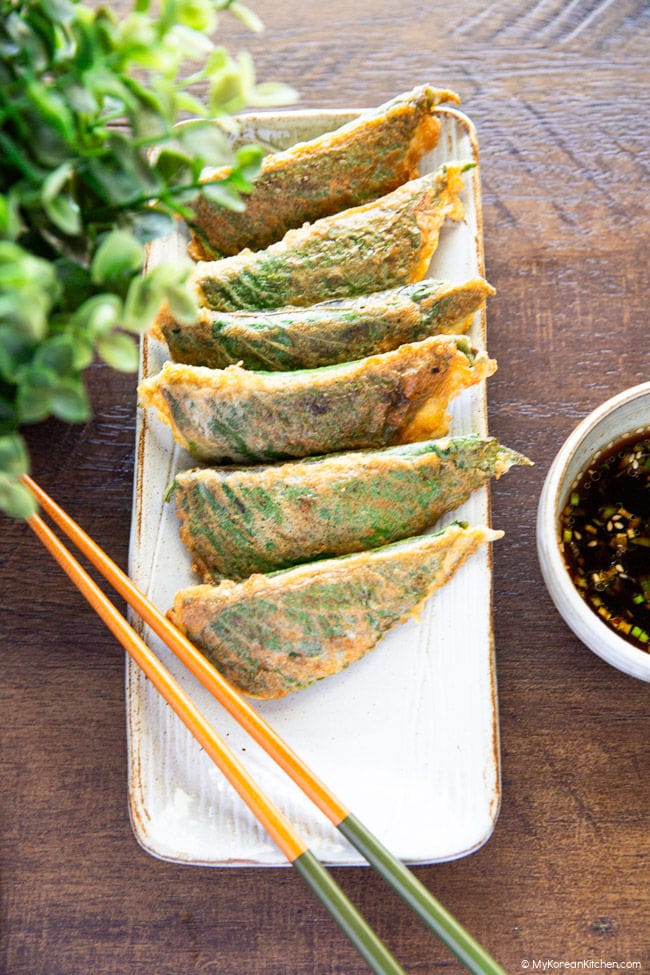
More Korean Jeon Recipes You Might Like
Jeon come in many shapes and flavors, and these are some of my go-to recipes that always bring a little extra comfort to the table.
- Hobak Jeon (Pan-Fried Zucchini Slices) – Simple zucchini slices lightly coated and pan-fried until golden.
- Kimchi Jeon (Kimchi Pancake) – Crispy kimchi pancakes with savory, tangy flavor in every bite.
- Pajeon (Green Onion Pancake) – A classic Korean pancake made with lots of green onions, crisp on the edges and soft in the middle.
- Pyogo Beoseot Jeon (Stuffed Shiitake Mushrooms) – Shiitake mushrooms filled with a savory meat mixture and pan-fried until golden.
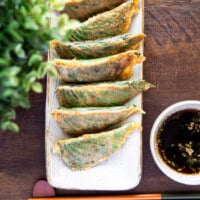
Stuffed Perilla Leaves (Kkaennip Jeon) - Golden Korean Pan-Fried Perilla Pockets
Ingredients
Filling
- 160 g ground pork or beef (5.6 oz)
- 1/2 Tbsp soy sauce , Sempio 701 Yangjo Ganjang or Kikkoman brand
- 1 tsp oyster sauce
- 1/2 tsp mirin (sweet cooking wine)
- 1 Tbsp minced garlic
- 1/8 tsp sesame oil
- A pinch black pepper (or to taste)
- 50 g firm tofu (1.8 oz), pressed to remove excess water and finely crumbled
- 50 g onion (1.8 oz), finely chopped
- 20 g green onion (0.7 oz), white part, finely chopped
- 30 g carrot (1 oz), finely chopped
- 1 whole egg
- 2 Tbsp Korean pancake mix (buchim garu) or plain flour
Wrapping
- 11 perilla leaves (kkaennip), medium, rinsed
Coating
- 1/4 cup plain flour , for dusting
- 2 whole eggs
- 1 egg yolk
- 1/4 tsp fine salt
- Cooking oil , for pan-frying
Instructions
- Season the meat: In a mixing bowl, combine the ground meat with the seasoning (soy sauce, oyster sauce, mirin, garlic, sesame oil, and black pepper). Mix well until evenly coated, then cover and let it rest while preparing the other ingredients so the flavors soak in.
- Cook the meat: Heat a lightly oiled pan over medium high heat. Add the seasoned meat and cook for 3 to 4 minutes, just until the color changes and most of the liquid evaporates. It doesn’t need to be fully cooked at this stage, since it will finish cooking once stuffed inside the perilla leaves. Break up any large clumps with a spatula as you stir.
- Prepare the filling: In a mixing bowl, combine the cooked meat with the tofu, onion, green onion, carrot, egg, and pancake mix. Mix by hand until the mixture feels sticky and cohesive. This texture will help it hold together as it cooks.
- Coat and stuff the perilla leaves: Lightly coat the back of each perilla leaf (the back side with the veins showing) with flour. Press it gently into a plate of flour, then shake off any excess. This helps the filling stick and keeps the front clean for a lighter finish. Spoon a small amount of filling onto one half of the leaf, then fold the other half over to cover and press lightly to seal. Repeat with the remaining leaves.
- Pan fry the jeon: Beat the eggs, yolk, and salt together in a shallow bowl. Heat a non-stick skillet over medium heat and add a thin layer of oil. Working one at a time, dip each stuffed perilla leaf into the egg mixture, coating both sides evenly, then place it straight into the pan. Fry in batches until golden brown and lightly crisp, about 2 to 3 minutes per side. Transfer to a plate lined with paper towels to drain excess oil. Serve warm.
Notes
Nutrition Info (per serving)
The nutrition information shown is an estimate provided by an online nutrition calculator. It should not be considered a substitute for a professional nutritionist’s advice.
